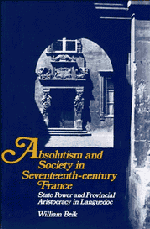 Absolutism and Society in Seventeenth-Century France
Absolutism and Society in Seventeenth-Century France Published online by Cambridge University Press: 05 July 2011
The exchange of taxes was another transaction which established relationships between king and rulers, rulers and population. Too often taxation has been conceptualized as extraction, the chief question being how much the king could draw from the province and how much the province could hold back. What was really at stake, however, was distribution, for Languedocian taxes represented one of the largest, most regular flows of liquid wealth in the province – one which could be tapped by those with influence or privilege. Taille collection siphoned off a substantial amount of the surplus produced by peasants and artisans and channelled it upwards towards the Estates and the king. Along the way it passed through the hands of a multitude of financier–collectors who profited from their possession of it in a variety of ways. When it reached its destination it was redistributed, often within the province. This system of collection and distribution affected the political stance taken by the various provincial institutions and the changing relations of certain individuals and groups to the crown. It was one of the major sources of new wealth for those on the rise, and it explains some of the anger against partisans which characterized the first half of the century. Most important, it provides another dimension in explaining the change in royal–provincial relations which took place after 1660.
To save this book to your Kindle, first ensure [email protected] is added to your Approved Personal Document E-mail List under your Personal Document Settings on the Manage Your Content and Devices page of your Amazon account. Then enter the ‘name’ part of your Kindle email address below. Find out more about saving to your Kindle.
Note you can select to save to either the @free.kindle.com or @kindle.com variations. ‘@free.kindle.com’ emails are free but can only be saved to your device when it is connected to wi-fi. ‘@kindle.com’ emails can be delivered even when you are not connected to wi-fi, but note that service fees apply.
Find out more about the Kindle Personal Document Service.
To save content items to your account, please confirm that you agree to abide by our usage policies. If this is the first time you use this feature, you will be asked to authorise Cambridge Core to connect with your account. Find out more about saving content to Dropbox.
To save content items to your account, please confirm that you agree to abide by our usage policies. If this is the first time you use this feature, you will be asked to authorise Cambridge Core to connect with your account. Find out more about saving content to Google Drive.